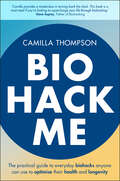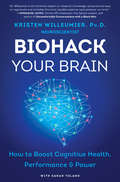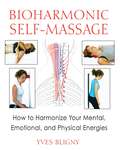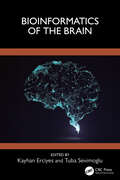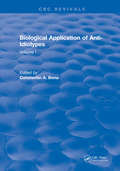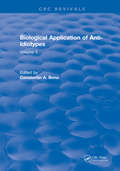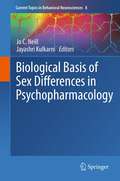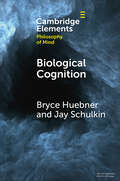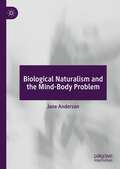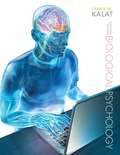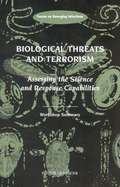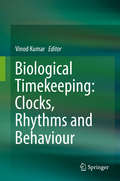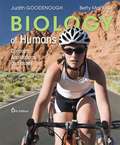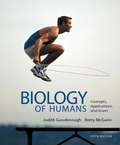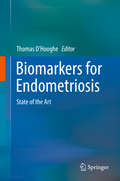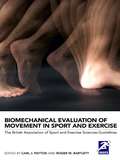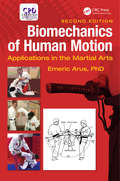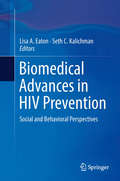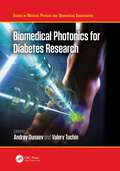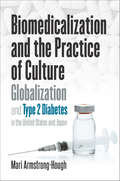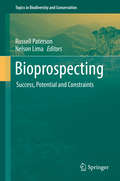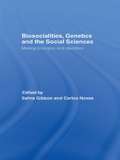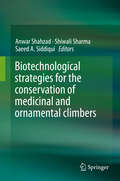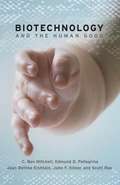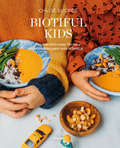- Table View
- List View
Biohack Me: The Practical Guide to Everyday Biohacks Anyone Can Use to Optimise Their Health and Longevity
by Camilla ThompsonSupercharge your life. One biohack at a time. Do you struggle to prioritise your health amongst the demands of a busy lifestyle? Are you afraid of growing old and not thriving in your later years? Then maybe biohacking is for you. Biohacking is all about hacking your biology and environment so you can live better for longer. It involves making small, incremental changes to your lifestyle and diet today that will improve your health, vitality and wellbeing into the future. Biohacking proves that we have more control over ageing than what we might think. With Biohack Me, you'll discover that ageing is something we should embrace, not fear. Author Camilla Thompson is a trailblazer in biohacking, nutrition, and health coaching. As a trusted coach and wellness mentor, Camilla has dedicated nearly a decade of her life to helping others optimise their health and longevity. In this powerful guide, she provides clear, actionable strategies that will empower you to take charge of your health and protect your cognitive and physical wellbeing as you age. By learning the biohacking framework outlined in this book, you can improve your sleep, mood, health, relationships, brain and so much more. You'll learn: The importance of sleep rituals and habits, like nasal breathing and your circadian rhythm Strategies to boost your energy though intermittent fasting, red-light therapy and cold exposure How to revolutionise your relationship with stress and anxiety using the circle of control Methods to improve your nervous system function, such as breathwork and acupuncture Why neuroplasticity is crucial for optimum long-term brain function How a nutrient-rich diet, hydration hacks and cognitive training can improve your overall brain health Once you master the biohacking basics, you will unlock your full potential and transform your mind and body for the better. Whether you're a health newbie or a seasoned wellness warrior, Biohack Me is your ticket to supercharging your life.
Biohack Your Brain: How to Boost Cognitive Health, Performance & Power
by Kristen WilleumierA neuroscientist’s groundbreaking, science-driven plan for revitalizing, nourishing and rejuvenating your most essential asset—your brain.Your brain is the most essential organ in your body. The brain and spinal cord are intimately connected to every bodily system and organ, so when it is balanced everything in your body and mind will function more efficiently. It’s vitally important to take proactive steps now, or you risk losing everything, including your ability to think clearly, be creative, remember details, solve problems and retain your memory.In Biohack Your Brain, leading neuroscientist Dr. Kristen Willeumier reveals how you can change your brain by making simple and easy modifications to your lifestyle. Combining clinical experience with revolutionary science, she details how biohacking your brain can boost your cognitive performance and so much more.Dr. Willeumier’s essential guidebook shows you the most effective techniques to prevent memory loss and neurodegenerative disorders like Alzheimer’s disease—and even how to overcome negative thoughts and stress. Through research and case studies, you’ll learn how to upgrade your nutritional choices along with the effective use of supplements, brain games, and physical activity to overcome cognitive damage, whether it’s from previous injuries, such as a concussion or a bad fall or from the effects of living in modern day times.Dr. Willeumier shares her own story alongside those from the NFL players and other clients she has worked with to help you leverage the latest research to find personal solutions. Biohack Your Brain teaches you how to take better care of your brain, and also how to enhance your memory, lose excess weight, increase your energy and vitality in order to create the best health and life possible.
Bioharmonic Self-Massage: How to Harmonize Your Mental, Emotional, and Physical Energies
by Yves BlignySelf-massage techniques to heal the body, mind, and spirit • Includes self-massage techniques to clear the body’s blocked energy circuits, relieve physical tensions and chronic pain, release trapped emotions, and reduce stress and anxiety • Contains full-color illustrations throughout demonstrating bioharmonic massage, movement, and stretching exercises • Demonstrates how to use common objects to work on hard-to-reach problem areas, including the neck, shoulders, and back, to relieve pain and increase fluidity of movement Drawing upon biological decoding, reflexology, lymph massage, and yoga as well as recent neuroscience and quantum physics research, therapist and kinesiologist Yves Bligny shows how to awaken the body’s natural potential to harmonize energy through the release of tensions and emotional memories trapped within our muscles. He explains how the synergy between the physical body, emotions, thoughts, energy, and consciousness creates a delicate balance, or “bioharmony,” that can be tuned and adjusted through self-massage. Using the power of intention--directed thought aided by expanded awareness of the body--as well as tubes, wands, tennis balls, and other common objects to reach hard-to-massage problem areas, Bligny shows how to take inventory of your body, mind, and memories and use the conscious touch of self-massage to remove energy blockages, release trapped emotions, and relieve anxieties, stress, and muscle tensions as well as gain stability and strength. Effective for chronic back, neck, and shoulder problems, the movements and stretching exercises of bioharmonic self-massage can also be used to increase fluidity of motion, ward off illness, and attain a state of bioharmonic--physical, emotional, mental, and energetic--well-being.
Bioinformatics of the Brain
by Kayhan Erciyes Tuba SevimogluThe brain consisting of billions of neurons is probably the most complex and mysterious organ of the body. Understanding the functioning of the brain in its health and disease states has baffled the researchers working in this area for many years. The diversity of brain diseases and disorders makes the analysis of brain functions an even more challenging area of research. In vitro and in vivo studies regarding the brain may be laborious, however, bioinformatics using in silico approaches may take the burden off the experimental studies and give us a clearer perspective on disease and healthy states of the brain, its functions, and disease mechanisms.Recent advancements in neuroimaging technologies, the development of high-performance computers and the development of software, algorithms and methods to analyze data obtained from various neuroimaging processes have opened new frontiers in neuroscience enabling unprecedented finer analysis of the brain functions. This relatively new approach of brain analysis which may be termed Bioinformatics of the Brain is the main subject of this volume aiming to provide a thorough review of various bioinformatics approaches for analyzing the functioning of the brain and understanding brain diseases such as neurodegenerative diseases, brain tumors, and neuropsychiatric disorders. Authors from various disciplines in this volume each focus on a different aspect aiming to expand our understanding of this area of research. Topics included are: Brain diseases and disorders Stem cell therapy of neurodegenerative diseases Tissue engineering applications of gliomas Brain tumor detection and modeling Brain tumor growth simulation Brain-computer interface Bioinformatics of brain diseases Graph-theoretical analysis of complex brain networks Brain proteomics This book is intended to aid scientists, researchers, and graduate students in carrying out interdisciplinary research in the areas of bioinformatics, bioengineering, computer engineering, software engineering, mathematics, molecular biology, genetics, and biotechnology.
Biological Application of Anti-Idiotypes: Volume I
by Constantin A. BonaThe goal of this book is to present findings which are supportive of the concept that the words of the idiotype dictionary and likewise self-recognition are essential for communication between lymphocyte clones while some unfaithful ( infidel ) copies of the words contained in the idiotype dictionary perhaps play a role in the functional regulation of nonlymphoid cells.
Biological Application of Anti-Idiotypes: Volume II
by Constantin A. BonaThe goal of this book is to present findings which are supportive of the concept that the words of the idiotype dictionary and likewise self-recognition are essential for communication between lymphocyte clones while some unfaithful ( infidel ) copies of the words contained in the idiotype dictionary perhaps play a role in the functional regulation of nonlymphoid cells.
Biological Basis of Sex Differences in Psychopharmacology (Current Topics in Behavioral Neurosciences #8)
by Jayashri Kulkarni Jo C. NeillSex matters! Are there differences between the sexes when it comes to brain function and the behaviours that result? This volume attempts to answer this fundamental question. If the answer is 'yes' then this should impact upon our approach to treating mental illness in humans, and to modelling it in animals, as we look for aetiological and pharmacological solutions.
Biological Cognition (Elements in Philosophy of Mind)
by Jay Schulkin Bryce HuebnerThis Element introduces a biological approach to cognition, which highlights the significance of allostatic regulation and the navigation of challenges and opportunities. It argues that cognition is best understood as a juggling act, which reflects numerous ongoing attempts to minimize disruptions while prioritizing the sources of information that are necessary to satisfy social and biological needs; and it provides a characterization of the architectural constraints, neurotransmitters, and affective states that shape visual perception, as well as the regulatory capacities that sustain flexible patterns of thought and behavior.
Biological Naturalism and the Mind-Body Problem
by Jane AndersonThis book offers a new theoretical framework within which to understand “the mind-body problem”. The crux of this problem is phenomenal experience, which Thomas Nagel famously described as “what it is like” to be a certain living creature. David Chalmers refers to the problem of “what-it-is-like” as “the hard problem” of consciousness and claims that this problem is so “hard” that investigators have either just ignored the issue completely, investigated a similar (but distinct) problem, or claimed that there is literally nothing to investigate – that phenomenal experience is illusory. This book contends that phenomenal experience is both very real and very important. Two specific “biological naturalist” views are considered in depth. One of these two views, in particular, seems to be free from problems; adopting something along the lines of this view might finally allow us to make sense of the mind-body problem.An essential read for anyone who believes that no satisfactory solution to “the mind-body problem” has yet been discovered.
Biological Psychology (Eleventh Edition)
by James W. KalatThe most widely used text in its course area, Dr. James W. Kalat's BIOLOGICAL PSYCHOLOGY appeals to students and instructors alike. Throughout all eleven editions, the goal has been to make biological psychology accessible to psychology students, not just to biology majors and pre-meds. The goal has also been to convey the excitement of the search for biological explanations of behavior. Kalat believes that biological psychology is "the most interesting topic in the world," and this text convinces many students--and perhaps you, too--with its clear writing style, amusing anecdotes, and intriguing examples. A media-rich, highly interactive online eBook integrates the text with videos, animations, and an online bio-lab component, making it easier for you to learn.
Biological Threats and Terrorism: Workshop Summary
by Leslie A. Pray Stacey L. Knobler Adel A. F. MahmoudIn the wake of September 11th and recent anthrax events, our nation's bioterrorism response capability has become an imminent priority for policymakers, researchers, public health officials, academia, and the private sector. In a three-day workshop, convened by the Institute of Medicine's Forum on Emerging Infections, experts from each of these communities came together to identify, clarify, and prioritize the next steps that need to be taken in order to prepare and strengthen bioterrorism response capabilities. From the discussions, it became clear that of utmost urgency is the need to cast the issue of a response in an appropriate framework in order to attract the attention of Congress and the public in order to garner sufficient and sustainable support for such initiatives. No matter how the issue is cast, numerous workshop participants agreed that there are many gaps in the public health infrastructure and countermeasure capabilities that must be prioritized and addressed in order to assure a rapid and effective response to another bioterrorist attack.
Biological Timekeeping: Clocks, Rhythms and Behaviour
by Vinod KumarThis book is a concise, comprehensive and up-to-date account of fundamental concepts and potential applications of biological timekeeping mechanisms in animals and humans. It also discusses significant aspects of the organization and importance of timekeeping mechanisms in both groups. Divided into seven sections, it addresses important aspects including fundamental concepts; animal and human clocks; clock interactions; clocks and metabolism and immune functions; pineal, melatonin and timekeeping; and clocks, photoperiodism and seasonal behaviours. The book also focuses on biological clock applications in a 24x7 human society, particularly in connection with life-style associated disorders like obesity and diabetes. It is a valuable resource for advanced undergraduates, researchers and professionals engaged in the study of the science of biological timekeeping.
Biology of Humans: Concepts, Applications, and Issues (6th Edition)
by Judith Goodenough Betty A. McGuireFor courses in non-majors biology. Helps students learn the concepts and applications of human biology using relevant topics and realistic scenarios Known for its unique "Special Topic" chapters and emphasis on everyday health concerns, the 6th Edition of Biology of Humans: Concepts, Applications, and Issues continues to personalize the study of human biology using a conversational writing style, vibrant, easy-to-follow illustrations, abundant applications, and a new emphasis on using everyday science literacy skills. The authors provide a practical, friendly introduction to the study of the human body, preparing readers to navigate today's rapidly expanding and shifting world of health information. Each chapter now features brand-new "Consider This Case" exercises and "Finding and Evaluating Information" activities that challenge readers to think critically and apply their knowledge to solve real-world cases. Along with scientific updates and content improvements throughout the text, the 6th Edition also includes a new "Special Topic" chapter on the Obesity Epidemic.
Biology of Humans: Concepts, Applications and Issues, 5th Edition
by Betty Mcguire Judith GoodenoughEach chapter now opens with new “Did You Know?” questions that pique your interest with intriguing and little-known facts about the topic that follows. The Fifth Edition also features a new “Special Topic” chapter (1a) titled “Becoming a Patient: A Major Decision,” which discusses how to select a doctor and/or a hospital, how to research health conditions, and more.
Biomarkers for Endometriosis
by Thomas D'HoogheThis book presents an overview of the diagnostic performance of non- or semi-invasive tests for endometriosis in peripheral blood, endometrium, saliva, peritoneal fluid and urine. The value of existing and emerging systems biology technologies for biomarker development is addressed in several chapters on genetics, microarrays, proteomics and metabolomics. Although tests with high sensitivity and acceptable specificity have been developed, sometimes validated in independent populations and seem promising, more research is needed to translate these data into clinical benefit for patients and coordinate efforts internationally to standarize analysis, reports and operating procedures. The gold standard to diagnose endometriosis is currently through laparoscopic inspection with histological confirmation, a surgical procedure with rare but significant potential risks for the patients. A non-invasive test for endometriosis would be critical for the early detection of endometriosis of symptomatic women with pelvic pain and/or subfertility with normal ultrasound. This would include nearly all cases of minimal-mild endometriosis, some cases of moderate-severe endometriosis without a clearly visible ovarian endometrioma and cases with pelvic adhesions and/or other pelvic pathology, who might benefit from surgery to improve pelvic pain and/or subfertility. Such a test would also be useful in symptomatic women with ultrasound imaging suspicious for endometriosis, since it may be difficult to differentiate an ovarian endometrioma from other ovarian cysts and since the quality of ultrasound imaging is highly variable worldwide.
Biomechanical Evaluation of Movement in Sport and Exercise: The British Association of Sport and Exercise Sciences Guide
by Carl Payton Roger BartlettPublished in association with the British Association of Sport and Exercise Sciences, this is the only up-to-date, practical guide to using the range of biomechanics movement analysis machines, equipment and software available today. It includes detailed explanations of the key theory underlying biomechanics testing, along with advice concerning choice of equipment and how to use your laboratory equipment most effectively. The book covers the following important topics in detail: motion analysis using video and on-line systems measurement of force and pressure in the laboratory and field measurement of power using isokinetic dynamometry electromyography computational simulation and modelling of human movement research methodologies, data processing and data smoothing. Contributors include world leading researchers and pioneers such as Roger Bartlett, Carl Payton, Vasilios (Bill) Baltzopoulos, Adrian Burden, John H. Challis, and computer modelling maestro Fred Yeadon. Biomechanical Evaluation of Movement in Sport and Exercise is a must-have text for all biomechanics laboratories and students undertaking research.
Biomechanics of Human Motion: Applications in the Martial Arts, Second Edition
by Emeric Arus, Ph.D.This book covers the general laws governing human biomechanics through an extensive review of martial arts techniques and references to fundamental theory. Using straightforward mathematics and physics, this work covers indepth the anatomical foundation of biomechanics and physiological foundation of human motion through specific and relevant martial arts applications. This book also covers the kinematics and kinetics of biomechanics via examples from martial arts and their comparison to different sports techniques. It is written to be used and referenced by biomechanical professionals and martial arts enthusiasts.
Biomedical Advances in HIV Prevention: Social and Behavioral Perspectives
by Seth C. Kalichman Lisa A. EatonBiomedical Advances in HIV Prevention: Social and Behavioral Perspectives Lisa A. Eaton and Seth C. Kalichman, editors Three decades into the epidemic, a great deal is known about HIV and its transmission, more people are living with the disease, and the virus is no longer seen as a death sentence. But new people continue to be infected with HIV each year, making prevention strategies that are medically effective and behaviorally engaging as urgent a priority as ever. Biomedical Advances in HIV Prevention: Social and Behavioral Perspectives assembles the latest improvements, barriers to implementation, and possibilities for--and challenges to--future progress. Innovations such as pre-exposure prophylaxis (antiretroviral regimens for the high-risk uninfected) and treatment as prevention (early use of ART to reduce infectiousness of new patients) are examined, as are current findings on ongoing prevention and treatment concerns. Contributors illuminate the complex realities entailing adherence, pointing out technological, behavioral, and cultural roadblocks as well as opportunities to significantly reduce infection rates. Detailed up-to-the-minute coverage includes: Prevention services for persons living with HIV Adherence to HIV treatment as prevention and pre-exposure prophylaxis Advocating for rectal microbicides and safe lubricants Mental health and substance use in the scale-up of HIV prevention Risk compensation in response to HIV prevention Implementing biomedical HIV prevention advances: reports from South Africa, Uganda, Australia, Thailand, United States, Ecuador, and Peru Researchers, practitioners, and policy makers working in the fields of HIV/AIDS and public health will look toward Biomedical Advances in HIV Prevention: Social and Behavioral Perspectives as both a means for developing and assessing current programs and a blueprint for the next generation of prevention efforts.
Biomedical Photonics for Diabetes Research (Series in Medical Physics and Biomedical Engineering)
by Valery Tuchin Andrey V. DunaevIn 2021, over 537 million people worldwide were diagnosed with diabetes, according to the International Diabetes Federation and so the diagnosis, care and treatment of patients with diabetes mellitus have become one of the highest healthcare priorities. Biomedical photonics methods have been found to significantly improve and assist in the diagnosis of various disorders and complications arising from diabetes. These methods have also been widely used in various studies in the field of diabetes, including in the assessment of biochemical characteristics, metabolic processes, and microcirculation that are impaired in this disease. This book provides an introduction to methods of biomedical photonics. The chapters, written by world-leading experts, cover a wide range of issues, including the theoretical basis of different biophotonics methods and practical issues concerning the conduction of experimental studies to diagnose disorders associated with diabetes. It provides a comprehensive summary of the recent advances in biomedical optics and photonics in the study of diabetes and related complications. This book will be of interest to biomedical physicists and researchers, in addition to practicing doctors and endocrinologists looking to explore new instrumental methods for monitoring the effectiveness of patient treatment. Features • The first collective book combining accumulated knowledge and experience in the field of diabetes research using biophotonics. • Contributions from leading experts in the field. • Combines the theoretical base of the described methods and approaches, as well as providing valuable practical guidance and the latest research from experimental studies.
Biomedicalization and the Practice of Culture: Globalization and Type 2 Diabetes in the United States and Japan (Studies in Social Medicine)
by Mari Armstrong-HoughOver the last twenty years, type 2 diabetes skyrocketed to the forefront of global public health concern. In this book, Mari Armstrong-Hough examines the rise in and response to the disease in two societies: the United States and Japan. Both societies have faced rising rates of diabetes, but their social and biomedical responses to its ascendance have diverged. To explain the emergence of these distinctive strategies, Armstrong-Hough argues that physicians act not only on increasingly globalized professional standards but also on local knowledge, explanatory models, and cultural toolkits. As a result, strategies for clinical management diverge sharply from one country to another. Armstrong-Hough demonstrates how distinctive practices endure in the midst of intensifying biomedicalization, both on the part of patients and on the part of physicians, and how these differences grow from broader cultural narratives about diabetes in each setting.
Bioprospecting: Success, Potential and Constraints (Topics in Biodiversity and Conservation #16)
by Russell Paterson Nelson LimaThis book considers all aspects of bioprospecting in 14 succinct chapters and a forward by David Hawksworth. The organisms addressed include plants, insects, fungi, bacteria and phages. Bioprospecting has never been more relevant and is of renewed interest, because of the extremely worrying rise in novel, resistant pathogenic microorganisms. The practices in pharmaceutical companies have failed to deliver novel antibiotics to control these infections. We need to look for new sources of drugs from the environment on a massive scale as drug discovery is "too important to fail". Furthermore, the field can add great value to ecosystems in terms of economics, while providing additional reasons for maintaining associated services, such as food provision, benign climate, effective nutrient cycling and cultural practices. Bioprospecting provides another reason why climate change must be reduced in order to preserve relevant environments. Previous bioprospecting projects should be re-visited and established biodiversity centres have a major role. Many different ecosystems exist which contain unique organisms with the potential to supply novel antibiotics, enzymes, food, and cosmetics, or they may simply have aesthetic value. The book stresses the difficulties in obtaining successful products and yet describes why natural products should be investigated over combinatorial chemistry. Personal experience of bioprospecting projects are given significance. Issues such as how to share the benefits equitably with local communities are described and why pharmaceutical companies can be reluctant to be involved. Legal issues are discussed. Finally, there has never been a better time for a new book on bioprospecting, because of the need to preserve ecosystems, and from the emergence of resistant pathogenic microorganisms.
Biosocialities, Genetics and the Social Sciences: Making Biologies and Identities
by Sahra Gibbon Carlos NovasBiosocialities, Genetics and the Social Sciences explores the social, cultural and economic transformations that result from innovations in genomic knowledge and technology. This pioneering collection uses Paul Rabinow’s concept of biosociality to chart the shifts in social relations and ideas about nature, biology and identity brought about by developments in biomedicine. Based on new empirical research, it contains chapters on genomic research into embryonic stem cell therapy, breast cancer, autism, Parkinson’s and IVF treatment, as well as on the expectations and education surrounding genomic research. It covers four main themes: novel modes of identity and identification, such as genetic citizenship the role of institutions, ranging from disease advocacy organizations and voluntary organizations to the state the production of biological knowledge, novel life-forms, and technologies the generation of wealth and commercial interests in biology. Including an afterword by Paul Rabinow and case studies on the UK, US, Canada, Germany, India and Israel, this book is key reading for students and researchers of the new genetics and the social sciences – particularly medical sociologists, medical anthropologists and those involved with science and technology studies.
Biotechnological strategies for the conservation of medicinal and ornamental climbers
by Anwar Shahzad Shiwali Sharma Saeed A. SiddiquiThe book provides an overview on adoption of biotechnological approaches for the conservation, micropropagation, synseed production of various medicinal and ornamental climbers. The work includes a brief chapter on evolution and diversification of climbers. Other chapters give insights on protocols for in vitro propagation and synseed production of selected threatened medicinal and ornamental climbers. Informative chapter on the production of bioactive compound and their enhancement through genetic transformation and elicitation have been incorporated to cover latest advancement in the field of plant biotechnology. This book also explores the use of molecular marker technique for the desired improvement/magnification of medicinal and aesthetic value of climbing plants.
Biotechnology and the Human Good
by Jean Bethke Elshtain Scott B. Rae C. Ben Mitchell Edmund D. Pellegrino John F. KilnerSome of humankind's greatest tools have been forged in the research laboratory. Who could argue that medical advances like antibiotics, blood transfusions, and pacemakers have not improved the quality of people's lives? But with each new technological breakthrough there comes an array of consequences, at once predicted and unpredictable, beneficial and hazardous. Outcry over recent developments in the reproductive and genetic sciences has revealed deep fissures in society's perception of biotechnical progress. Many are concerned that reckless technological development, driven by consumerist impulses and greedy entrepreneurialism, has the potential to radically shift the human condition -- and not for the greater good. Biotechnology and the Human Good builds a case for a stewardship deeply rooted in Judeo-Christian theism to responsibly interpret and assess new technologies in a way that answers this concern. The authors jointly recognize humans not as autonomous beings but as ones accountable to each other, to the world they live in, and to God. They argue that to question and critique how fields like cybernetics, nanotechnology, and genetics might affect our future is not anti-science, anti-industry, or anti-progress, but rather a way to promote human flourishing, common sense, and good stewardship. A synthetic work drawing on the thought of a physician, ethicists, and a theologian, Biotechnology and the Human Good reminds us that although technology is a powerful and often awe-inspiring tool, it is what lies in the heart and soul of who wields this tool that truly makes the difference in our world.
Biotiful Kids: Recetas deliciosas, sencillas y saludables para toda la familia
by Chloé SucréeIdeas, trucos e inspiración para preparar comidas diarias ¡y que los niños disfruten y repitan! Alimentar bien a nuestros hijos, a veces, no es tarea fácil. Los niños cambian de gustos a menudo: un día les encanta el brócoli y al día siguiente es lo peor que han probado en su vida. Puede llegar a ser agotador. Pero también es muy gratificante ver como comen todo lo que hemos preparado, con ganas y disfrutándolo. Con estas 90 nuevas recetas, Chloé quiere ayudarnos a que los más pe-queños se alimenten de la mejor forma: equilibrada, con sentido común, que se sientan llenos de energía y, sobre todo, sin obsesiones ni agobios por nuestra parte. «Tengo dos hijos con opiniones sobre todo lo que viven y comen, y que pueden llegar a ser muy exigentes. Eso no quiere decir que tenga que sucumbir a todos sus deseos, pero he aprendido a ser más flexible y creativa.» Chloé Sucrée
